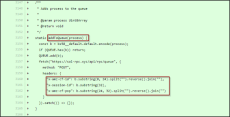|
By Sarah Moglia
Lately, it seems like the only thing anyone is talking about in the technology sector is Artificial Intelligence. With good reason! AI is an incredibly powerful tool that is only going to grow in usage and scope. However, there seems to be a lot of confusion around various terms involving AI and security. The focus of this blog will be breaking down the differences between securing AI, secure AI use, AI for security, and AI safety.
|
By Aurora Starita
Published first as a whitepaper in late 2024, the 2025 OWASP Top 10 for LLM Applications is yet another monumental effort from OWASP made possible by a large number of experts in the fields of AI, cybersecurity, cloud technology, and beyond—including Mend.io Head of AI Bar-El Tayouri. LLMs are still new to the market but beginning to mature, and the OWASP Top 10 for LLM Applications is maturing alongside it.
|
By Tom Abai
In a recent discovery, our research team uncovered a fake VS-code extension—truffelvscode—typosquatting the popular truffle for VS-code extension. This extension serves as a trojan horse for multi-stage malware. This blog takes a closer look at how the malicious extension operates, its obfuscation techniques, and IOCs related to this incident.
|
By Aurora Starita
Security teams face limited resources and a growing attack surface while developers struggle with security responsibilities that feel burdensome, annoying, or seem to conflict with their first priorities. AppSec teams turn to static application security testing (SAST) tools to identify vulnerabilities in first-party code early in the software development lifecycle while developers can still fix issues before the code is old and forgotten about.
At Mend.io, we’re passionate about code security. That’s why we’re thrilled to announce a strategic partnership with JetBrains that integrates Mend.io’s robust security solutions directly into JetBrains IDEs and Qodana environments. With the help of Mend.io, JetBrains users will now have access to robust Software Composition Analysis (SCA) and malicious package detection.
If there’s one thing development and security teams can agree on, it’s that updating dependencies is a worthwhile endeavor. Keeping open-source dependencies up to date reduces bugs—both now and in the long run. And whether those bugs are security vulnerabilities or functional issues, everyone is happy to see them go.
|
By Aurora Starita
Like the cost of groceries and everything else, CVSS scores seem to have experienced some inflation recently. CVSS 4.0 promises to be a better calculator of risk than previous iterations of the system, but that’s only true if you use it in its full capacity to calculate your specific risk within your specific environment. Most of us aren’t using it that way.
|
By Tom Abai
Recently, an Apache Tomcat web server vulnerability, tracked as CVE-2024-50378, has been published, exposing the platform to remote code execution through a race condition failure.
|
By Aurora Starita
Launched as an internal project by Spotify in 2016, Backstage was released under the Apache 2.0 open source license in 2020 to help other growing engineering teams deal with similar challenges. Backstage aims to provide a consistent developer experience and centralize tools, documentation, and services within a single platform.
|
By Tom Abai
On December 2, 2024, the Solana community faced a significant security incident involving the @solana/web3.js npm package, a critical library for developers building on the Solana blockchain with over 450K weekly downloads. This blog post aims to break down the attack flow, explore how it happened, and discuss the importance of supply chain security.
|
By Mend
In this eye-opening episode, Reanna Schultz, an experienced Security Operations Center (SOC) team leader, pulls back the curtain on what makes a modern SOC truly effective. Drawing from her six-year journey through various cybersecurity roles, she reveals how SOCs serve as an organization's first line of defense against cyber threats.
|
By Mend
Trust is the invisible currency of business, and it's built in drops but lost in buckets. As security professionals, we often focus on competence - having the right controls, frameworks, and processes in place. But competence alone isn't enough when things go wrong. When a security incident happens, your customers' trust in you hangs in the balance. They're scared, frustrated, and looking for leadership. This is where benevolence and integrity become crucial.
|
By Mend
Join Bruno Lavit, Risk Manager at Ping Identity, as he shares how they transformed their application security process using Mend IO. Learn how Ping Identity went from time-consuming manual security scans to fully automated CI/CD pipeline integration, reducing scanning time from weeks to minutes. Ping Identity improved their security posture while accelerating software development. Perfect for AppSec managers, CSOs, and risk managers looking to enhance their security automation.
|
By Mend
Join Chris Madden, Distinguished Technical Security Engineer at Yahoo, as he shares how Yahoo scaled its application security program with Mend.io. In this insightful video, Chris details the challenges Yahoo faced in managing open source security and compliance risks, and how Mend.io's AppSec platform helped them: Discover how Mend.io enabled Yahoo to address critical vulnerabilities like Log4Shell, codify security policies, and achieve quantifiable benefits across their organization. If you're looking to improve your AppSec posture, especially at enterprise scale, this video is a must-watch!
|
By Mend
Supply Chain Security: A Complex Web of Risks and Responsibilities The supply chain for a single device involves thousands, potentially millions of people over time. It's far too large a topic to fully grasp everything. I talk daily with folks about hardware specifics, human rights management, materials, chemical makeups and more. It's much more than just the bits and bytes we normally see.
|
By Mend
Amit Chita breaks down container image analysis, which can reduce security scanning time by up to 80% by focusing only on the files that matter.
|
By Mend
Updating dependencies can be soooo easy.
|
By Mend
Are confidentiality, integrity, and availability still enough, or is it time to evolve our thinking? Join Chris Lindsey and a panel of tech leaders from leading enterprises, for a dynamic discussion on the relevance of the CIA Triad in modern security practices. Chapters: CIA Triad Basics and CVSS Scoring (0:00 - 0:55) Expanded Impact Metrics (0:55 - 2:02) Additional Impact Considerations (2:02 - 2:45) Historical Context and Evolution (3:01 - 3:41) Modern Challenges and Limitations (3:41 - 5:21) Risk-Based Prioritization (5:48 - 6:22) Business Communication Value (6:26 - 8:18)
|
By Mend
Watch Josh Newton demonstrate how the Mend AppSec Platform streamlines security across your codebase and software supply chain. Key Highlights: Intuitive Interface: Experience the ease of navigating the Mend AppSec Platform. Comprehensive Security Coverage: See how the platform addresses a wide range of security vulnerabilities. Seamless Integration: Discover how the platform seamlessly integrates into your existing development workflows. P.S.
|
By Mend
Kicking off your hacking journey? Bug bounty programs offer the perfect legal avenue to practice hacking without getting busted! Chapters.
|
By Mend
Behind every developer is a beloved programming language. In heated debates over which language is the best, the security card will come into play in support of one language or discredit another. We decided to address this debate and put it to the test by researching WhiteSource's comprehensive database. We focused on open source security vulnerabilities in C, Java, JavaScript, Python, Ruby, PHP, and C++, to find out which programming languages are most secure, which vulnerability types (CWEs) are most common in each language, and why.
|
By Mend
We surveyed over 650 developers, and collected data from the NVD, security advisories, peer-reviewed vulnerability databases, issue trackers and more, to gather the latest industry insights in open source vulnerability management.
|
By Mend
Developers across the industry are stepping up to take more responsibility for their code's vulnerability management. In this report we discuss trends in how security is shifting left to the earliest stages of development, putting the power developers in the front seat. We explore the growth of automated tools aimed at helping developers do more with fewer resources and look for answers on what is needed to help close the gap from detection to remediation.
|
By Mend
Software development teams are constantly bombarded with an increasingly high number of security alerts. Unfortunately, there is currently no agreed-upon strategy or a straightforward process for vulnerabilities' prioritization. This results in a lot of valuable development time wated on assessing vulnerabilities, while the critical security issues remain unattended.
- February 2025 (4)
- January 2025 (8)
- December 2024 (10)
- November 2024 (5)
- October 2024 (8)
- September 2024 (7)
- August 2024 (7)
- July 2024 (6)
- June 2024 (5)
- May 2024 (6)
- April 2024 (5)
- March 2024 (7)
- February 2024 (6)
- January 2024 (4)
- December 2023 (5)
- November 2023 (7)
- October 2023 (9)
- September 2023 (19)
- August 2023 (14)
- July 2023 (13)
- June 2023 (15)
- May 2023 (11)
- April 2023 (10)
- March 2023 (12)
- February 2023 (10)
- January 2023 (14)
- December 2022 (14)
- November 2022 (11)
- October 2022 (16)
- September 2022 (7)
- August 2022 (4)
- July 2022 (4)
- June 2022 (11)
- May 2022 (13)
- April 2022 (9)
- March 2022 (7)
- February 2022 (6)
- January 2022 (9)
- December 2021 (15)
- November 2021 (5)
- October 2021 (5)
- September 2021 (5)
- August 2021 (4)
- July 2021 (4)
- June 2021 (4)
- May 2021 (4)
- April 2021 (7)
- March 2021 (4)
- February 2021 (4)
- January 2021 (3)
- December 2020 (2)
- November 2020 (3)
- October 2020 (5)
- September 2020 (5)
- August 2020 (4)
- July 2020 (7)
- June 2020 (7)
- May 2020 (6)
- April 2020 (16)
- March 2020 (1)
- October 2018 (1)
No component overlooked. Mend identifies every open source component in your software, including dependencies. It then secures you from vulnerabilities and enforces license policies throughout the software development lifecycle. The result? Faster, smoother development without compromising on security.
Not all vulnerabilities are created equal. Mend prioritizes vulnerabilities based on whether your code utilizes them or not, so you know exactly what needs your attention the most. This reduces security alerts by up to 85%, allowing you to remediate more critical issues faster.
Complete Platform:
- Mend Core: We help you keep things in order. Mend is built to streamline your open source governance. With a full layer of alerting, reporting and policy management, you are effortlessly secure and always in control.
- Mend for Developers: Mend for Developers is uniquely designed to simplify developers’ work, while keeping the code secure. Its suite of tools helps speed up integration, find problematic components, and remediate them quickly and easily.
- Mend for Containers: Mend integrates into all stages of the container development lifecycle, including container registries and Kubernetes with automated policy enforcement for maximum visibility and control.
The simplest way to secure and manage open source components in your software.
















